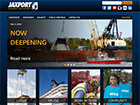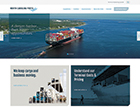Web Cite City
Ports

America’s Central Port
http://www.americascentralport.com
America’s Central Port, which is managed by the Tri-City Regional Port District, is strategically located in the heart of the United States on the Mississippi River, and adjacent to an excellent highway system. The Port and its tenants offer a wide range of services and facilities, including: barge, rail, and truck commodity transfer; industrial, commercial, and residential development sites; and warehouse and commercial lease opportunities.

Florida Ports Council
The Florida Ports Council (FPC) is a nonprofit corporation that serves as the professional association for Florida’s 15 public seaports and their management. The FPC provides advocacy, leadership, and information on seaport-related issues before the legislative and executive branches of state and federal government. The FPC believes a strong, strategic, public/private partnership between Florida’s ports and state and local government will enable the diverse seaports to continue their vast economic contributions to every region of the state.

Georgia Ports Authority
The Georgia Ports Authority (GPA) includes the Port of Savannah, the Port of Brunswick, the Bainbridge Inland Barge Terminal, and the Columbus Inland Barge Terminal. Its home page offers history and background about the Ports Authority, a port directory, shipping directory, GPA statistics, maps, photos, and more.

Jacksonville Port Authority
JAXPORT is Florida’s No. 1 container port complex, the second busiest vehicle port in the U.S., and home to one of the nation’s highest weight-bearing capacity docks. Deepening of the Jacksonville Harbor to accommodate the largest ships calling the U.S. East Coast is now underway. The port offers worldwide service from dozens of ocean carriers to more than 100 ports around the world. Located in Northeast Florida, in the heart of the South Atlantic, JAXPORT is a full service, international trade seaport situated at the crossroads of the nation’s rail and highway network with access to more than 60 million consumers within a one-day truck drive. JAXPORT. It’s Just Smart Business.

Maryland Port Administration
Located in the nation’s third-largest consumer group, the Port of Baltimore has an impressive array of distribution locations, with more on the way. As an import destination from China, the most cost-effective and quickest way to tap this affuent market is by bringing your cargo direct to Baltimore, where you will be greeted with world-class effciency and customer service. Find out more at mpa.maryland.gov.

North Carolina Ports
North Carolina Ports offers convenient port locations in Wilmington and Morehead City. Recent improvements in Wilmington have included berth renovations, turning basin expansion, and an expansion of the container yard that tripled refrigerated container capacity. Add accessibility to rail and interstate highway routes, plus customized, white-glove service, and NC Ports can meet customer needs better than ever.

Northwest Seaport Alliance
The Northwest Seaport Alliance brings together two of the nation’s premier harbors to form a single, integrated gateway. Located in the Pacific Northwest, we offer shorter Asia transits and are the first and last ports of call for many transpacific services. Our combined terminals, carriers and ports of call provide flexibility to suit unique supply chain needs. And our commitment to provide cost-effective, innovative shipping solutions is unparalleled.

Port Canaveral
Port Canaveral can help you get cargo to market faster and easier. Cargo operations at Port Canaveral make the most of its geography, saving time and money, while reaching more than 58 million people in the U.S. Southeast, as well as markets in Central and South America, the Caribbean, Africa and Europe. Port Canaveral is closer to more major Florida markets than any other port, and its unique, uncongested proximity to rail, highway and air further reduces distribution time and costs.

Port Corpus Christi
http://www.portofcorpuschristi.com
Strategically located on the western Gulf of Mexico, Port Corpus Christi is the sixth-largest port in the United States in total tonnage. With a straight, 45-foot deep channel, the port provides quick access to the Gulf, the U.S. inland waterway system, and the world beyond. The port delivers outstanding access to overland transportation with on-site and direct connections to three Class I railroads, and uncongested interstate and state highways. With outstanding management and operations staff, Port Corpus Christi is clearly "More Than You Can Sea."

Port Everglades
Nobody moves cargo in and out faster than Port Everglades. The port is part of a thriving global transportation network that counts among its attributes a favorable location less than one mile from the Atlantic Shipping Lane, direct access to multimodal inland links through Florida’s interstate and highway systems, and an FEC rail hub within two miles. Across the street is Fort Lauderdale Airport, one of the fastest-growing airports in the nation. Visit the Web site for more details.

Port of Brownsville
http://www.portofbrownsville.com
The Port of Brownsville is the only deepwater port located on the U.S.-Mexico Border. With approximately 40,000 acres of land available for development and 17 miles of waterfront access, the port offers a direct route to non-congested international bridge crossings and rail connections. The Port of Brownsville handles a wide variety of cargo including steel products, liquid, break bulk, and dry bulk commodities. With the facilities and knowledge to handle international cargo, we facilitate efficient movement of goods between the United States and Mexico.

Port of Greater Baton Rouge
This deepwater (45-foot) port is located at the junction of the Mississippi River and Gulf Intracoastal Waterway, which provides a shorter route to Houston by 160 miles. Information on 525,000 square feet of transit shed space, 3,000 feet of continuous berthing space, an unlimited turning basin, midstream transfer buoys, and a new intermodal barge terminal are available at the port’s web site, along with capability specifics, contacts, and pertinent links.

Port of Halifax
Halifax is perfectly positioned to provide international shippers with rapid access to the eastern and central markets of Canada and the United States. It is one of the few ports on the East Coast of North America capable of handling fully laden post-Panamax vessels. Halifax is a multi-purpose port capable of handling every configuration of cargo, including container, ro/ro, bulk, breakbulk, and special project, heavy lift. The diversity of the port is accommodated through our two container terminals, an automobile handling facility, and two common-user multi-purpose facilities.

Port of Houston
Visit the Port of Houston’s Web site and choose from a menu of items. Check out facilities, shipping and service directories, frequently asked questions, and transportation and shipping links. The site also features the latest economic impact information, container and booking information, and trade statistics. The Port of Houston, the world’s eighth-largest port, is a 25-mile-long complex of public and private facilities, just a few hours of sailing time from the Gulf of Mexico.

Port of Lehavre
The Port of LeHavre’s geographic position — at the western edge of the range of Northern European ports — allows it to offer the shortest transit times for European goods, both exports and imports. The Port of Le Havre is the first port of call for seagoing vessels servicing the Northern European greater economic zone, and the last loading station prior to major ocean crossings. Check out details about France’s leading port for foreign trade by visiting the web site.

Port of Long Beach
The Port of Long Beach is one of the world’s busiest seaports, a leading gateway for trade between the United States and Asia. During the next 10 to 15 years, the Port of Long Beach plans to create at least four container terminals of more than 300 acres each, and to build at least one other large terminal. The new terminals will have dockside rail facilities, which allow cargo to be transferred directly between ships and trains. Such transfers speed deliveries between Long Beach and markets nationwide. For more information on the advantages and services offered by the Port of Long Beach, visit www.polb.com.

Port of Long Beach
The Port of Long Beach is one of the world’s busiest seaports, a leading gateway for trade between the United States and Asia. During the next 10 to 15 years, the Port of Long Beach plans to create at least four container terminals of more than 300 acres each, and to build at least one other large terminal. The new terminals will have dockside rail facilities, which allow cargo to be transferred directly between ships and trains. Such transfers speed deliveries between Long Beach and markets nationwide. For more information on the advantages and services offered by the Port of Long Beach, visit www.polb.com.

Port of Los Angeles
The Port of Los Angeles is the busiest container port in the United States, sustaining its rank as number one for over two decades with record volumes for containerized trade. An industry linchpin, the Port is an established leader of maintaining an efficient, sustainable supply chain, and a trailblazer in modernization and cybersecurity, taking a leadership role in adopting new technologies to improve the reliability, predictability, and efficiency of the flow of cargo across global seaborne trade. Both competitive and collaborative, the Port of Los Angeles serves as an economic bellwether and the premier international trade gateway of Southern California.

Port of Miami
http://www.metro-dade.com/portofmiami/
In response to your demands for more efficient cargo services, The Port of Miami’s five-year improvement program will renovate existing structures and facilities and enable construction of new ones. Projects include completing a dredging program, increasing cargo handling capacity and throughput, and berth and container yard enhancements. Visit the port’s web site for more information.

Port of New Orleans
The Port of New Orleans is at the center of the world’s busiest port complex — Louisiana’s Lower Mississippi River. Its proximity to the Midwest makes New Orleans the port of choice for moving steel, grain, containers and manufactured goods. The Port of New Orleans is the only deepwater port in the United States served by six Class One railroads, giving users direct and economical rail service to or from anywhere in the country. In the last 10 years, the Port of New Orleans has invested nearly $500 million in new state-of-the-art facilities. Find out why The Port New Orleans should be your port of choice, visit the web site today.
